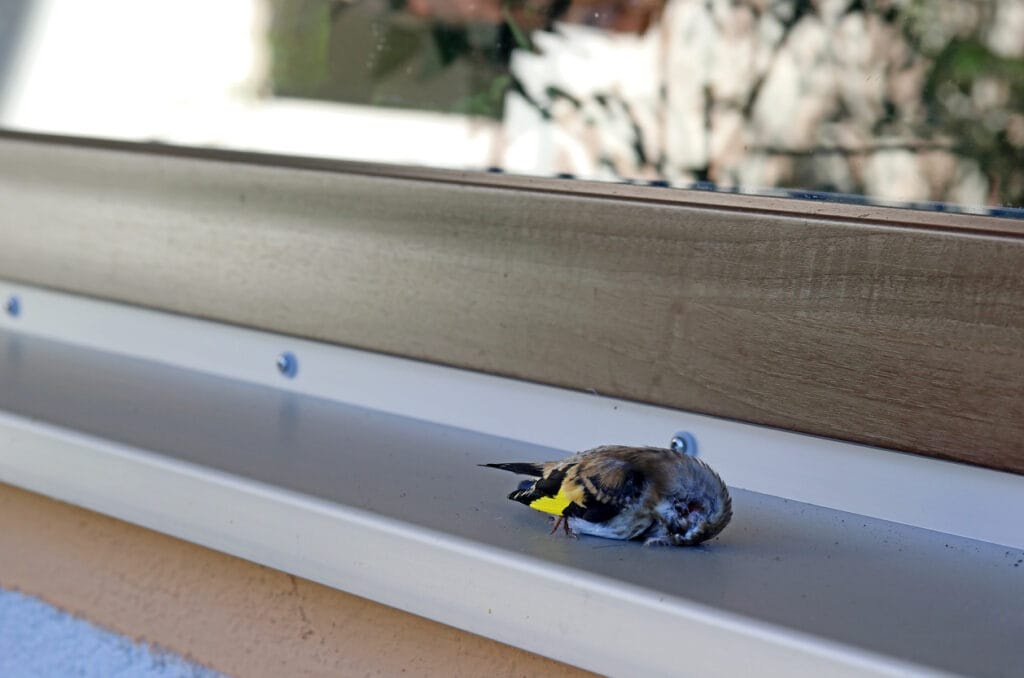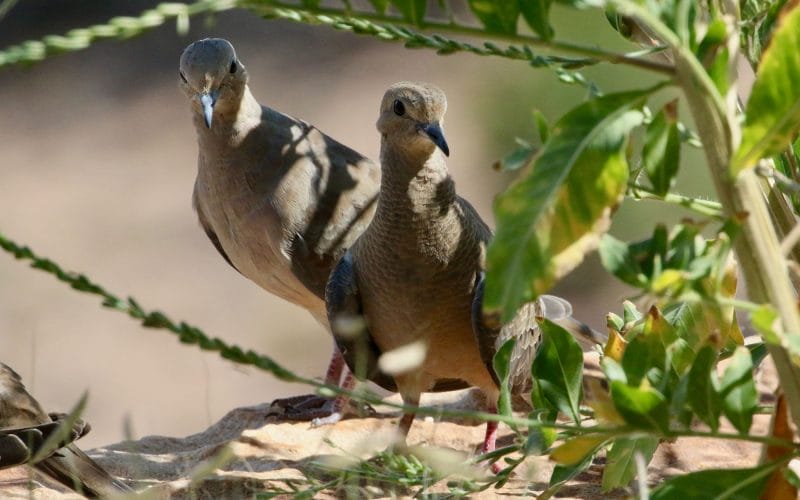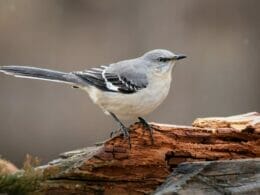Whether you’ve stumbled across one, or it hit your windows, we’ve all found an unconscious bird at least once in our lives. Since a bird doesn’t do much after hitting a window, one question you might be asking yourself then “how to tell if a bird is stunned or dead”?
The best way to tell if a bird is stunned or dead is by checking the bird for signs of slow breathing or heartbeats. If the bird is still breathing then it is most likely stunned and will recover if left alone. If the bird is not breathing or moving, it may be dead. Either way, we recommend leaving the bird alone for a few minutes to ensure it has time to recover naturally.
In the following article, you’ll know how to identify a stunned bird and even help it recover itself back into the wild!
Let’s dive in!
How to Tell if a Bird is Alive
When you find the bird, you’ll need to check if it’s dead or just stunned by the impact.
As previously mentioned, birds that are just stunned will look unresponsive, all fluffed up, and weak.
However, you’ll notice that they either breathe out quickly or very slow.
Make sure that you give the bird 10 minutes of recurrent checking for movements or recovery before deciding that the bird is dead.
Of course, the sure way to confirm that the bird is dead is by using a stethoscope and listen to the bird’s heartbeats.
Keep in mind that birds have a different cardiac rhythm from ours, even distant and very weak heartbeats are enough to keep some birds alive.
What to Do if a Bird Hits Your Window

Now that you know how to tell if a bird is dead or just out-cold from the shock, it’s time to know what to do if you come across this unfortunate event.
In this section, you’ll find a brief step by step guide that has everything you need to know:
Step 1: Find and Observe the Bird
If a bird hits your windows, you’ll probably hear a knock on the glass but the bird won’t be necessarily right under it.
In some cases, a bird might last a couple of seconds after the hit that it can fly a few feet away before it blacks out.
Author Note: If you don’t find the bird right beneath the window, look for the bird around the site of the collision.
Before you attempt to touch the bird, observe it well, and see how it reacts to your presence. As a rule of thumb, a stunned bird will likely remain dormant until it recovers but will look weak with hanging wings.
Step 2: Examine the Bird and Look for Signs of Injury
If the bird is just unconscious, it’ll probably recover on its own unless it’s suffering from an injury that requires immediate medical care.
Before picking up the bird, you can visually inspect the bird and check for any visible injuries, such as wounds, bleeding, or broken bones. You may also find some missing feathers or wet discharges from their bills.
It’s perfectly okay to pick the bird up as long as you do it gently and you wear gloves to protect both you and the birds from infections.
If the bird isn’t suffering from any further injuries that might hinder the recovery process, you’re good to go ahead and prepare the bird for recovery.
However, if the bird shows signs of severe injury, it’ll require appropriate medical care. In that case, it would be better to leave the job for healthcare professionals.
Step 4: Prepare a Safe Shelter for the Bird
Ideally, leaving the bird in the area where you’ve found it is the best option if this area is safe and free from predators and curious children.
If you’re concerned about the bird’s safety in that spot, you can transfer it to a safer shelter. Get a small box that is large enough to let the bird spread its wings when it recovers.
You may also want to line the box with some old newspaper or a soft clean rag to keep the bird comfortable.
Remember to make sure that the box has plenty of holes to keep the shelter well ventilated. A shoebox is usually a great option to consider.
Gently transfer the bird inside the box, close the lid carefully, and keep the box in a quiet and warm spot if it’s cold outside.
Author Note: You don’t need to add any food in the box for this short period that you’re hosting the injured bird.
You can add a very small amount of water in a shallow dish that isn’t too much that they’d drown the bird if spilled over.
Step 5: Let the Bird Rest and Recover
The reason for keeping the box covered is that stunned birds require as little stimulation as possible as they recover from a shock.
The time needed by a bird to rest and recover depends on the species of the bird, the severity of the injury, and how long it has been since you’ve found it.
Generally, you should this period to last anywhere from 10 minutes and up to 3 or 4 hours. Avoid the temptation to poke the bird or open the box frequently to check on it.
Similar to the previous step, if it has been over 4 hours and the bird didn’t recover, it’s time to contact an expert wildlife rehabilitator.
Step 6: Release the Bird
Now that it has been at least a couple of hours inside the box, the bird should be ready to be released back into the wild.
First, you should take the box outside, whether it’s in your backyard or from a balcony. Once you remove the lid the bird will mostly fly out of the box on its own.
However, if it’s conscious but remains in the box, you should offer your hand for the bird to stand on. The bird will mostly fly off once you raise your hand up.
What to Do if the Bird is Dead

If you’re sure that the bird is dead, there are some steps that you need to do. Here’s what you need to know:
Dealing with the Carcass
Some people want to dispose of the bird’s carcass, either by wrapping them in a bag or burying them.
If you’re planning to deal with the carcass yourself, make sure that you keep it safe from the hands of scavenger animals that might start digging holes to reach the body of the bird.
Top Tip: If you’re burying the bird, make sure the hole is at least 2 feet deep.
When to Report the Bird’s Death
For the average backdoor and common birds, there’s no need to report the death. However, there are certain cases where reporting the bird’s death is the right thing to do, such as:
- If the birds aren’t usually found in your area (migrating bird)
- If they appear shot or killed by a human in hunting controlled region
- The incidence occur frequently or in the same spot (probability for nearby poisoning)
- If the bird is a raptor of any kind
- If the bird is outfitted with tracking equipment
Who Should You Call if the Bird is in a Seriously Bad Shape
If you can’t deal with a stunned bird or a dead raptor, it’s best to call a licensed wildlife rehabilitator to tend to the bird.
The Humane Society of the United States offers an index that may help you connect with the right authorities per state.
Things to Avoid While Saving a Stunned Bird
There are also some points that you need to consider if you want to avoid hurting yourself or the bird while trying to help it. Let’s have a quick look at them.
- Giving the bird food and water of unknown safety: food is unnecessary in this short period. Also, not all birds will handle small bits of food.
- Trying to physically examine the bird yourself: unless you’re an expert, you might actually do more harm than good.
- Giving the Bird Medications
- Keeping your pets around the injured bird: whether it’s a cat or a dog, even the most behaved pet might react unexpectedly when introduced to a wild bird.
- Keeping the wild bird as a pet: keeping a wild animal as a pet isn’t only a bad idea, but it can also be punishable by the law if you don’t have a permit, especially if it’s an endangered or a protected bird.
- Releasing the bird indoors
- Handling birds of prey: raptors, such as eagles, vultures, falcons, etc, can be extremely dangerous once they regain consciousness, which is why it’s recommended to call a wildlife rehabilitator immediately if you spot a stunned one.
Why Birds Get Stunned

There are plenty of reasons for birds to get stunned. One of the most common reasons they get stunned is window collisions.
Although birds are quite intelligent creatures, windows and mirrors reflect sceneries that the bird mistakes for physical objects, such as tree branches, foraging sources, or even clear paths, especially when they’re trying to escape a predator.
Another reason for stunned birds is being shot with bullets or hit by a predator that failed to find them after they fall. Earth collision upon wing injuries is also a fatal cause of stuns.
Wrap Up
With that said, you now know how to tell if a bird is stunned or dead. Also, you know how to take care of the bird and avoid mistakes that can be bad for both you or the bird!
Fly high friends!
FAQ
The duration of time a bird will stay stunned depends on the severity of the injury or trauma and the species of the bird. For example, a mild concussion can cause a bird to be stunned for only a few minutes, while a more severe injury can cause the bird to be stunned for several hours or even days. Certain birds may recover quickly and fully after being stunned, while others may have permanent damage or simply may not survive. Factors that can affect the recovery time include the bird’s age, overall health, and the type of injury or trauma it has sustained.
It’s generally not recommended to touch a stunned bird, as they can carry diseases. Additionally, handling a stunned bird can cause further stress or injury, and may interfere with the bird’s ability to recover. However, if you must handle a stunned bird, wear gloves and handle it gently, using a towel or a soft cloth to keep it warm. Keep the bird in a quiet, dark and warm place until the bird recovers or until you can transport it to a veterinarian or a wildlife rehabilitator.
A stunned bird may display uncoordinated movements, drowsiness or lethargy, closed eyes, fast breathing and pupil response. It may appear weak, wobbly, or disoriented and may have trouble standing or flying.










